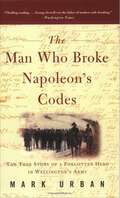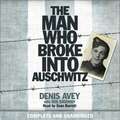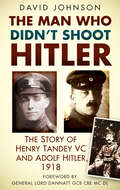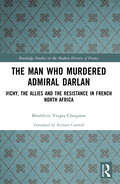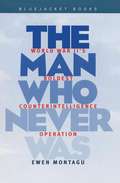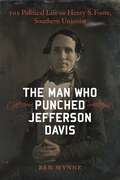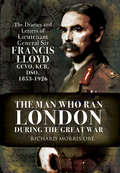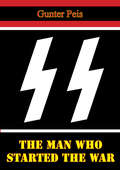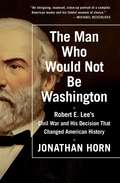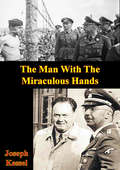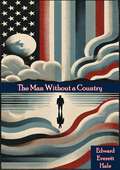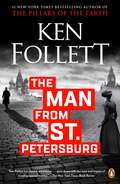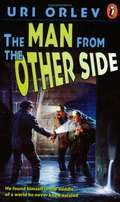- Table View
- List View
The Man Who Broke Napoleon's Codes: The True Story of a Forgotten Hero in Wellington's Army
by Mark UrbanThe little-known story of a brilliant British code-cracker: &“[Urban] has pieced together the fragments and deciphered the truth about a hidden hero.&” —Daily Telegraph The Duke of Wellington—who began his military career as Arthur Wellesley—is rightly credited for the strategic and intelligence-gathering brilliance that culminated in Britain&’s defeat of Napoleon at Waterloo. Two centuries later, many of his subordinates are still remembered for their roles in these historic campaigns. But Lt. Col. George Scovell is not among them. This is the story of a man of common birth—bound, according to the severe social strictures of eighteenth-century England, for the life of a tradesman—who would become his era&’s most brilliant code-breaker and an officer in Wellesley&’s army. In an age when officers were drawn almost exclusively from the ranks of the nobility, George Scovell—an engraver&’s apprentice—joined Wellesley in 1809. Scovell provides a fascinating lens through which to view a critical era in military history—his treacherous rise through the ranks despite the scorn of his social betters, and his presence alongside Wellesley in each of the major European campaigns from the Iberian Peninsula through Waterloo. But Scovell was more than just a participant in those events. Already recognized as a gifted linguist, Scovell would prove a remarkably nimble cryptographer. Encoded communiqués between Napoleon and his generals, intercepted by the British, were brought to Scovell for his skilled deciphering. As Napoleon&’s encryption techniques became more sophisticated, Wellesley came to rely ever more on Scovell&’s genius for this critical intelligence. In Scovell&’s lifetime, his role in Britain&’s greatest military victory was grudgingly acknowledged, but his accomplishments would eventually be credited to others—including Wellington himself. His name—and contributions—have been largely overlooked.The Man Who Broke Napoleon&’s Codes tells the fascinating story of the early days of cryptology, re-creates the high drama of some of Europe&’s most remarkable military campaigns, and restores the mantle of hero to a man heretofore forgotten by history. &“Combine[s] the fast-paced narrative of a spy novel with colorful period detail describing the inner workings of an army staff at war.&” —Library Journal &“Thrilling reading.&” —The Washington Times
The Man Who Broke into Auschwitz: The Extraordinary True Story (Extraordinary Lives, Ext Ser.)
by Denis Avey Rob BroombyTHE INTERNATIONAL BESTSELLERTHE MAN WHO BROKE INTO AUSCHWITZ is the extraordinary true story of a British soldier who marched willingly into Buna-Monowitz, the concentration camp known as Auschwitz III.In the summer of 1944, Denis Avey was being held in a POW labour camp, E715, near Auschwitz III. He had heard of the brutality meted out to the prisoners there and he was determined to witness what he could. He hatched a plan to swap places with a Jewish inmate and smuggled himself into his sector of the camp. He spent the night there on two occasions and experienced at first-hand the cruelty of a place where slave workers, had been sentenced to death through labour. Astonishingly, he survived to witness the aftermath of the Death March where thousands of prisoners were murdered by the Nazis as the Soviet Army advanced. After his own long trek right across central Europe he was repatriated to Britain. For decades he couldn't bring himself to revisit the past, but now Denis Avey feels able to tell the full story - a tale as gripping as it is moving - which offers us a unique insight into the mind of an ordinary man whose moral and physical courage are almost beyond belief.
The Man Who Broke into Auschwitz: The Extraordinary True Story (Extraordinary Lives, Extraordinary Stories of World War Two #8)
by Denis Avey Rob BroombyTHE INTERNATIONAL BESTSELLERTHE MAN WHO BROKE INTO AUSCHWITZ is the extraordinary true story of a British soldier who marched willingly into Buna-Monowitz, the concentration camp known as Auschwitz III.In the summer of 1944, Denis Avey was being held in a POW labour camp, E715, near Auschwitz III. He had heard of the brutality meted out to the prisoners there and he was determined to witness what he could. He hatched a plan to swap places with a Jewish inmate and smuggled himself into his sector of the camp. He spent the night there on two occasions and experienced at first-hand the cruelty of a place where slave workers, had been sentenced to death through labour. Astonishingly, he survived to witness the aftermath of the Death March where thousands of prisoners were murdered by the Nazis as the Soviet Army advanced. After his own long trek right across central Europe he was repatriated to Britain. For decades he couldn't bring himself to revisit the past, but now Denis Avey feels able to tell the full story - a tale as gripping as it is moving - which offers us a unique insight into the mind of an ordinary man whose moral and physical courage are almost beyond belief.
The Man Who Broke into Auschwitz: The Extraordinary True Story (Extraordinary Lives, Extraordinary Stories of World War Two #8)
by Denis Avey Rob BroombyTHE MAN WHO BROKE INTO AUSCHWITZ is the extraordinary true story of a British soldier who marched willingly into Buna-Monowitz, the concentration camp known as Auschwitz III.In the summer of 1944, Denis Avey was being held in a POW labour camp, E715, near Auschwitz III. He had heard of the brutality meted out to the prisoners there and he was determined to witness what he could. He hatched a plan to swap places with a Jewish inmate and smuggled himself into his sector of the camp. He spent the night there on two occasions and experienced at first-hand the cruelty of a place where slave workers, had been sentenced to death through labour. Astonishingly, he survived to witness the aftermath of the Death March where thousands of prisoners were murdered by the Nazis as the Soviet Army advanced. After his own long trek right across central Europe he was repatriated to Britain. For decades he couldn't bring himself to revisit the past that haunted his dreams, but now Denis Avey feels able to tell the full story - a tale as gripping as it is moving - which offers us a unique insight into the mind of an ordinary man whose moral and physical courage are almost beyond belief. (P)2011 Hodder & Stoughton
The Man Who Counts: Polesotechnic League Book 1 (POLESOTECHNIC LEAGUE)
by Poul AndersonNicholas Van Rijn: Interstellar Merchant Prince one moment, barbarian chattel the next. Marooned half a world and an ocean away from the sole human outpost on a planet whose very water is poisonous to humans; captured by winged barbarians in the midst of a brutal war of extermination, somehow 'Old Nick' must scheme, conspire, wrangle and battle his way to survival.
The Man Who Didn't Shoot Hitler: The Story of Henry Tandey VC and Adolf Hitler, 1918
by David JohnsonThis is the tale of two men.The first is Henry Tandey, an ordinary man later deemed to be ‘a hero of the old berserk type’, born and brought up in Leamington Spa, Warwickshire, who displayed extraordinary courage to emerge from the First World War as the most decorated British private to survive. The second is Adolf Hitler, who was highly decorated in his service to Germany in the First World War and went on to become one of the most infamous dictators in history, later bringing the world to the brink of destruction during the Second World War. It seems unlikely that their fates should collide. Yet in 1938 Hitler named Tandey as the soldier who spared his life on 28 September 1918 in the aftermath of the Battle of Marcoing – an assertion that came as a surprise to Tandey himself. The Man Who Didn’t Shoot Hitler tells the story of Tandey’s and Hitler’s Great War, the moment when their lives became intertwined – if in fact they did – and how Tandey lived with the stigma of being known not for his chestful of medals for gallantry in service of King and Country, but as the man who let Hitler live.
The Man Who Discovered Antarctica: Edward Bransfield Explained: The First Man to Find and Chart the Antarctic Mainland
by Sheila BransfieldThe definitive biography of the British naval officer who found the Antarctic shoreline in the early nineteeth century. Captain Cook claimed the honor of being the first man to sail into the Antarctic Ocean in 1773, which he circumnavigated the following year. Cook, though, did not see any land, and declared that there was no such thing as the Southern Continent. Fifty years later, an Irishman who&’d been impressed into the Royal Navy at eighteen, and risen through the ranks to the position of master, proved Cook wrong, discovering and charting parts of the Antarctic shoreline. He also discovered Elephant Island and Clarence Island, claiming them for the British Crown. Edward Bransfield&’s naval career included taking part in the Bombardment of Algiers in 1816 onboard the 50-gun warship HMS Severn. Then, in 1817, he was posted to the Royal Navy&’s Pacific Squadron off Valparaíso in Chile, and it was while he served there that the skipper of an English whaling ship, the Williams, was driven south by adverse winds and discovered what came to be known as the South Shetland Islands where Cook had said there was no land. Bransfield&’s superior officer, Captain Sherriff, decided to investigate further. He chartered Williams and sent Bransfield with two midshipmen and a ship&’s surgeon into the Antarctic—and the Irishman sailed into history. Despite many parts of Antarctica and an Antarctic survey vessel being named after him, and a Royal Mail commemorative stamp issued in his name, the full story of this remarkable man and his historic journey, have never been told—until now. Following decades of research, Sheila Bransfield MA, a member of the UK Antarctic Heritage Trust, has produced the definitive biography of one of Britain&’s greatest maritime explorers. The book also includes a foreword by the Trust&’s patron the Princess Royal. &“Bransfield&’s meticulous research gives us a detailed account of the daily routines of the Navy and the immense amount of maintenance required of a large wooden warship in the Age of Sail.&” —Historical Novel Society
The Man Who Flew the Memphis Belle
by Robert Morgan Ron Powers"Bring[s] a new perspective to World War II literature...Exciting" -- Library Journal. A powerful chronicle of loyalty, love, and heroism under fire, this is the unforgettable memoir of a member of the Greatest Generation who fought in America's greatest battles-and of the war one man waged both in and out of the skies. High-spirited young Robert Morgan was transformed from a fast-living, privileged playboy who grew up hobnobbing with the Vanderbilts into a steel-nerved pilot forged in the cauldron of World War II's most dangerous and desperate aerial encounters. This is the triumphant tale of that transformation-and of the plane and crew that never failed to bring him back home.
The Man Who Knew Too Much: Alan Turing and the invention of computers
by David LeavittThe story of Alan Turing, the persecuted genius who helped break the Enigma code and create the modern computer.To solve one of the great mathematical problems of his day, Alan Turing proposed an imaginary programmable calculating machine. But the idea of actually producing a 'thinking machine' did not crystallise until he and his brilliant Bletchley Park colleagues built devices to crack the Nazis' Enigma code, thus ensuring the Allied victory in the Second World War. In so doing, Turing became a champion of artificial intelligence, formulating the famous (and still unbeaten) Turing test that challenges our ideas of human consciousness.But Turing's work was cut short when, as an openly gay man in a time when homosexuality was illegal in Britain, he was apprehended by the authorities and sentenced to a 'treatment' that amounted to chemical castration. Ultimately, it lead to his suicide, and it wasn't until 2013, after many years of campaigning, that he received a posthumous royal pardon. With a novelist's sensitivity, David Leavitt portrays Turing in all his humanity - his eccentricities, his brilliance, his fatal candour - while elegantly explaining his work and its implications.
The Man Who Murdered Admiral Darlan: Vichy, the Allies and the Resistance in French North Africa (Routledge Studies in the Modern History of France)
by Bénédicte Vergez-ChaignonIn November 1942 Anglo-American forces landed in French North Africa, which soon afterwards broke with Marshal Pétain’s Vichy regime in France and re-entered the war on the Allies’ side. On Christmas Eve the high commissioner Admiral François Darlan was assassinated in Algiers. Why? Like the press and public opinion in Britain and America, General Charles de Gaulle’s Free French movement and the resistance in France were appalled that the Allies had allowed Darlan to retain office, even though as prime minister under Pétain he had previously advocated military collaboration with Nazi Germany. Few mourned Darlan’s death, many were relieved, some were jubilant. His killer was Fernand Bonnier de la Chapelle. Who was this twenty year old and what drove him to murder? Bénédicte Vergez-Chaignon paints a sympathetic portrait of the young idealist manipulated by local resistance leaders. As she tells Bonnier’s story, the author illuminates the imbroglio of North Africa’s competing political forces. She traces Bonnier’s short life, the assassination, his court-martial and execution within 48 hours, the subsequent judicial investigations which became bogged down in the complex rivalry between the Allies, the remnants of the Vichy regime, the Resistance and other factions. The story ends with Bonnier’s posthumous rehabilitation and recognition as a member of the French Resistance. Bonnier’s biography reads like an absorbing novel, with its twists and turns, reconstructed dialogue and author’s acute observations. As well as being a tragic human story, It is an illuminating study of the convoluted political context of the affair, which will be unfamiliar to some Anglophone readers. It is an academically rigorous piece of original research, based in part on previously inaccessible family archives Bénédicte Vergez-Chaignon’s story of Darlan’s assassination was received in France as * ‘a shocking book and a historian’s great work’ (Le Patriote Résistant) * ‘a detailed enquiry … bordering on a detective novel which brings out the conspiratorial atmosphere reigning in Algiers in the wake of the Allied landing of 8 November 1942’ (Le Monde des Livres) * it ‘shows the extent to which the 1940s were years of complete ambiguity’ (Le Figaro Littéraire) * ‘Bénédicte Vergez-Chaignon, a meticulous historian, paints the portrait of a young idealist dying to wash away the stain of defeat’ (Midi Libre).
The Man Who Never Was
by Ewen MontaguAs plans got under way for the Allied invasion of Sicily in June 1943, British counter-intelligence agent Ewen Montagu masterminded a scheme to mislead the Germans into thinking the next landing would occur in Greece. The innovative plot was so successful that the Germans moved some of their forces away from Sicily, and two weeks into the real invasion still expected an attack in Greece. This extraordinary operation called for a dead body, dressed as a Royal Marine officer and carrying false information about a pending Allied invasion of Greece, to wash up on a Spanish shore near the town of a known Nazi agent.Agent Montagu tells the story as only an insider could, offering fascinating details of the difficulties involved-especially in creating a persona for a man who never was--and of his profession as a spy and the risks involved in mounting such a complex operation. Failure could have had devastating results. Success, however, brought a decided change in the course of the war.
The Man Who Punched Jefferson Davis: The Political Life of Henry S. Foote, Southern Unionist (Southern Biography Series)
by Ben WynneRegarded as one of the most vocal, well-traveled, and controversial statesmen of the nineteenth century, antebellum politician Henry Stuart Foote played a central role in a vast array of pivotal events. Despite Foote’s unique mark on history, until now no comprehensive biography existed. Ben Wynne fills this gap in his examination of the life of this gifted and volatile public figure in The Man Who Punched Jefferson Davis: The Political Life of Henry S. Foote, Southern Unionist.An eyewitness to many of the historical events of his lifetime, Foote, an opinionated native Virginian, helped to raise money for the Texas Revolution, provided political counsel for the Lone Star Republic’s leadership before annexation, and published a 400-page history of the region. In 1847, Mississippi elected him to the Senate, where he promoted cooperation with the North during the Compromise of 1850. One of the South’s most outspoken Unionists, he infuriated many of his southern colleagues with his explosive temperament and unorthodox ideas that quickly established him as a political outsider. His temper sometimes led to physical altercations, including at least five duels, pulling a gun on fellow senator Thomas Hart Benton during a legislative session, and engaging in run-ins with other politicians—notably a fistfight with his worst political enemy, Jefferson Davis. He left the Senate in 1851 to run for governor of Mississippi on a pro-Union platform and defeated Davis by a small margin. Several years later, Foote moved to Nashville, was elected to the Confederate Congress after Tennessee seceded, and continued his political sparring with the Confederate president.From Foote’s failed attempt to broker an unauthorized peace agreement with the Lincoln government and his exile to Europe to the publication of his personal memoir and his appointment as director of the United States mint in New Orleans, Wynne constructs an entertaining and nuanced portrait of a singular man who constantly challenged the conventions of southern and national politics.
The Man Who Ran London During the Great War: The Diaries and Letters of Lieutenant General Sir Francis Lloyd, GCVO, KCB, DSO, 1853–1926
by Richard MorrisIn 1913 Lieutenant General Sir Francis Lloyd was appointed to the supreme position reserved for Guardsmen, the command of the London Districts. The war saw an extension of his responsibilities to include the hospitals and main railway termini in the metropolis. He was also put in charge of the construction of the defensive circle of trenches around London. Whether it was meeting hospital trains returning from the front with wounded soldiers, or visiting areas of the City that had suffered from the Zeppelin and Gotha Bomber air raids, Francis Lloyds presence would help to revive the populations flagging morale. This led him to be described by newspapers as The Man who runs London.
The Man Who Rode the Thunder
by William H. RankinIt was July 26, 1959. An F8U Crusader jet fighter streaked across the sky, down the Carolina coast, close to the speed of sound. Altitude: 47,000 feet. Flying conditions: Perfect. Marine Lt. Colonel William Rankin gave only a fleeting glance at the mounting black thunderheads far below. Seconds later began the most incredible 40 minutes in history. Here is the thrilling, detailed account of how Col. Rankin was forced to bail out at almost 50,000 feet without special pressure equipment. How, after dropping 7 miles in a free fall, he plunged into the grip of a violent storm--an inferno of turbulence, rain, hail, thunder and lightning such as no man had ever seen before. For over a half hour, Col. Rankin was an airborne captive of the storm, and his eventual survival was against overwhelming odds. Here is the true story behind that headline-making event. And here is the adventurous life of the Marine--a life that fitted him so well for the fantastic ordeal he was forced to undergo. You will go with Col. Rankin as he recalls his adventures as a Marine Sergeant in World War II; into early flight training to become one of the three oldest cadets ever admitted for flying. You will fly with him as one of the famous "Fearless Four" as they bomb the bridges of Toko-Ri in Korea. You will know the thrill of trailblazing the jet age when Col. Rankin assumes command of the famous Marine Fighter Squadron 122. Finally, you will share one of the most astounding adventures of modern times--a thrilling epic of man against the terrifying forces of nature--the story of a man who survived because he had lived and trained in the true tradition of the United States Marine Corps. This book also serves as an important contribution to medical inquiries into what happens to man at great altitudes.
The Man Who Saw Too Much: David Brill, Combat Cameraman
by John LittleThis is the story of David Brill, one of the very best of Australian cameramen - past and present. He is in the same company as Damien Parer and Neil Davis.Over the past forty years he has covered wars and disasters all over the world. He filmed the fall of Saigon. He was in Moscow during the collapse of communism. He has covered countless other conflicts and natural disasters in Asia, Africa and North and South America.He has been single-mindedly dedicated to the pursuit of his craft: to get the story, get the film - always to preserve and present the human dimension, no matter how large or mindless the conflict or event.David Brill has paid a high price for this uncompromising style. He has two failed marriages, and at times has been overcome by demons such as alcohol. This biography is also a great adventure story, a journey through war zones and various hell holes of the world. And it is an inside look at what makes some people follow a profession where their life is on the line - as a standard feature of their day.
The Man Who Started the War
by Günter PeisThe True Story of THE MAN WHO STARTED THE WARAs a key member of Hitler's sinister secret police, he lied, forged, kidnapped, seduced, murdered... On August 1939 he became the man who started World War II..."Adolf Hitler, his devastating war machine primed and ready to roll, needed an excuse to touch off World War II."The Führer presented the problem to Heydrich, notorious chief of the SD. Heydrich called up Naujocks. Together they worked out plans for a Polish "invasion" of German soil."At dusk, August 31, 1939, Naujocks and six chosen men set out for the little border town of Gleiwitz."They were in Polish uniforms..."At dawn, September 1, 1939, the Panzers were rolling across the border.""I am me man who started me war...I lit the fuse in-Europe in 1939--"--Major Alfred Helmut Naujocks, SD, BerlinAt 26, Alfred Naujocks was the key man in Hitler's sinister SD organization, the man who:Sent 35,000 Red Army officers to their deathsForged millions of British five pound notesSet up the world's most exclusive brothel in BerlinStaged the fantastic murder plot that touched off the holocaust of World War IIWas himself marked for extermination by his Nazi masters because he knew too much
The Man Who Used the Universe
by Alan Dean FosterA notorious criminal pursues peace—and power—with alien enemies in this sci-fi novel from the #1 New York Times–bestselling author of The Damned Trilogy. No one knows the true motives of Kees vaan Loo-Macklin. He&’s a mastermind criminal who gave up his place at the head of the dark underworld to become a legitimate member of Evenwaith&’s cities. But soon he was reaching out to powerful enemies—-the slimy aliens called the Nuel. Loo-Macklin negotiates an illusory peace agreement and gains precious alien secrets in the process. Is he after peace, power or pure evil? With enemy starships beginning to amass, we won&’t have to wait long to find out.
The Man Who Used the Universe
by Alan Dean FosterA notorious criminal pursues peace—and power—with alien enemies in this sci-fi novel from the #1 New York Times–bestselling author of The Damned Trilogy. No one knows the true motives of Kees vaan Loo-Macklin. He&’s a mastermind criminal who gave up his place at the head of the dark underworld to become a legitimate member of Evenwaith&’s cities. But soon he was reaching out to powerful enemies—-the slimy aliens called the Nuel. Loo-Macklin negotiates an illusory peace agreement and gains precious alien secrets in the process. Is he after peace, power or pure evil? With enemy starships beginning to amass, we won&’t have to wait long to find out.
The Man Who Would Not Be Washington: Robert E. Lee's Civil War and His Decision That Changed American History
by Jonathan HornThe “compelling…modern and readable perpective” (USA TODAY) of Robert E. Lee, the brilliant soldier bound by marriage to George Washington’s family but turned by war against Washington’s crowning achievement, the Union.On the eve of the Civil War, one soldier embodied the legacy of George Washington and the hopes of leaders across a divided land. Both North and South knew Robert E. Lee as the son of Washington’s most famous eulogist and the son-in-law of Washington’s adopted child. Each side sought his service for high command. Lee could choose only one. In The Man Who Would Not Be Washington, former White House speechwriter Jonathan Horn reveals how the officer most associated with Washington went to war against the union that Washington had forged. This extensively researched and gracefully written biography follows Lee through married life, military glory, and misfortune. The story that emerges is more complicated, more tragic, and more illuminating than the familiar tale. More complicated because the unresolved question of slavery—the driver of disunion—was among the personal legacies that Lee inherited from Washington. More tragic because the Civil War destroyed the people and places connecting Lee to Washington in agonizing and astonishing ways. More illuminating because the battle for Washington’s legacy shaped the nation that America is today. As Washington was the man who would not be king, Lee was the man who would not be Washington. The choice was Lee’s. The story is America’s. A must-read for those passionate about history, The Man Who Would Not Be Washington introduces Jonathan Horn as a masterly voice in the field.
The Man With The Miraculous Hands: The Fantastic Story Of Felix Kersten, Himmler's Private Doctor (Biography Index Reprint Ser.)
by Joseph KesselFelix Kersten, physician to the high-demon of the Third Reich, Heinrich Himmler could alleviate Himmler’s severe stomach pains with his hands using massage and manipulation. In return, Kersten bargained with Himmler to order the release of innocent prisoners condemned to die.It is an amazing story of the good-natured little fat man who looked like a “cross between a Flemish burgomaster and a Buddha of the West,” studied the higher curative powers of massage under a lama-doctor Ko, and applied them to Himmler whose excruciating stomach aches were only relieved by Kersten’s therapy. During the five years to come, Kersten attended Himmler but was an alien by birth and sympathies among his entourage, with the one exception of Himmler’s private secretary who collaborated with him in drawing up the lists of doomed men—Jehovah’s Witnesses, Jews, concentration camp victims of all nationalities. At the close, Kersten was jockeying with Himmler (and when persuasion failed, withholding treatment) to try and secure mass scale liberation of victims first through Sweden, then Switzerland.... Kersten is fascinating to follow-through his circumspect, ambivalent career—even though there may be points in question at its close.—KIRKUS Review
The Man With the Iron Heart: The Definitive Biography of Reinhard Heydrich, Architect of the Holocaust
by Nancy DoughertyA fascinating portrait of Reinhard Heydrich, one of the darkest figures of Hitler's elite, featuring words with those who knew him best, including in-depth and rare interviews with his wife, Lina. He was called the 'Hangman of the Gestapo' and the 'Butcher of Prague'. He had a reputation as a ruthlessly efficient killer and was known as an exemplar of Nazi ideals. He was the head of the SS and the Gestapo, second in command to Heinrich Himmler and supposedly in line to succeed the Fuhrer.His orders set in motion the Kristallnacht pogrom of 1938 and he was the lead planner of the Final Solution, which led to the murder of millions of Jews across Nazi-occupied Europe.Hitler called him 'the man with the iron heart'.This incredible biography explores who Reinhard Heydrich was, how he came to be and what led him to do what he did.Using in-depth research, Nancy Dougherty (and, following her death, Christopher Lehman-Haupt), paint a detailed picture of Heydrich as never seen before. Through extensive interviews with those who knew him best, including his wife Lina von Osten Heinrich, we hear about his rarefied musical family origins and ugly-duckling childhood, his failed Naval career and struggles to find employment, and finally his meteoric rise through the Nazi high command and his time within the Third Reich.The Man With the Iron Heart is an astonishing journey into the depths of Nazi evil and a powerful insight into one of humanity's darkest figures.
The Man Without a Country
by Edward Everett HaleEdward Everett Hale’s The Man Without a Country is a timeless tale of patriotism, redemption, and the profound human need for connection and belonging. Originally published during the American Civil War, this poignant novella tells the story of Philip Nolan, a young U.S. Army officer whose rash words during a trial lead him to be sentenced to a life of exile at sea, forbidden from ever hearing or speaking of his homeland again.Through Nolan’s journey, Hale masterfully explores themes of national identity, the consequences of impulsive actions, and the deep ties that bind individuals to their country. Nolan’s gradual transformation—from a brash, disillusioned man to someone who deeply regrets his estrangement—offers a powerful commentary on the meaning of loyalty and the importance of cherishing one’s heritage.Told through the fictional memoirs of a naval officer who befriends Nolan, the story is both intimate and grand, blending personal tragedy with larger reflections on the American spirit. Its enduring message resonates far beyond its Civil War-era context, offering a universal meditation on the value of freedom, duty, and community.A classic of American literature, The Man Without a Country continues to inspire readers with its moving portrayal of a man’s search for redemption and the enduring ties to the land he once forsook. Perfect for readers of all ages, this novella is a stirring reminder of the power of forgiveness and the enduring love for one’s homeland.
The Man from St. Petersburg
by Ken Follett"Ken Follett has done it once more . . . goes down with the ease and impact of a well-prepared martini." —New York Times Book ReviewHis name was Feliks. He came to London to commit a murder that would change history. A master manipulator, he had many weapons at his command, but against him were ranged the whole of the English police, a brilliant and powerful lord, and the young Winston Churchill himself. These odds would have stopped any man in the world—except the man from St. Petersburg.From the Paperback edition.
The Man from the Other Side
by Uri Orlev Hillel HalkinA Pole, 14-year-old Marek helps his stepfather smuggle goods into the Jewish ghetto, enduring trips through the foul sewers not from altruism but in order to reap lucrative profits. When Marek decides to help another Jew, his actions lead him into the ghetto during the peak of the uprising. "The author's refusal to exaggerate gives the story unimpeachable impact".--Publishers Weekly.
The Man in the Gray Flannel Suit
by Sloan WilsonUniversally acclaimed when first published in 1955, The Man in the Gray Flannel Suit captured the mood of a generation. Its title -- like Catch-22 and Fahrenheit 451 -- has become a part of America's cultural vocabulary. Tom Rath doesn't want anything extraordinary out of life: just a decent home, enough money to support his family, and a career that won't crush his spirit. After returning from World War II, he takes a PR job at a television network. It is inane, dehumanizing work. But when a series of personal crises force him to reexamine his priorities -- and take responsibility for his past -- he is finally moved to carve out an identity for himself. This is Sloan Wilson's searing indictment of a society that had just begun to lose touch with its citizens. The Man in the Gray Flannel Suit is a classic of American literature and the basis of the award-winning film starring Gregory Peck. "A consequential novel. " -- Saturday Review
